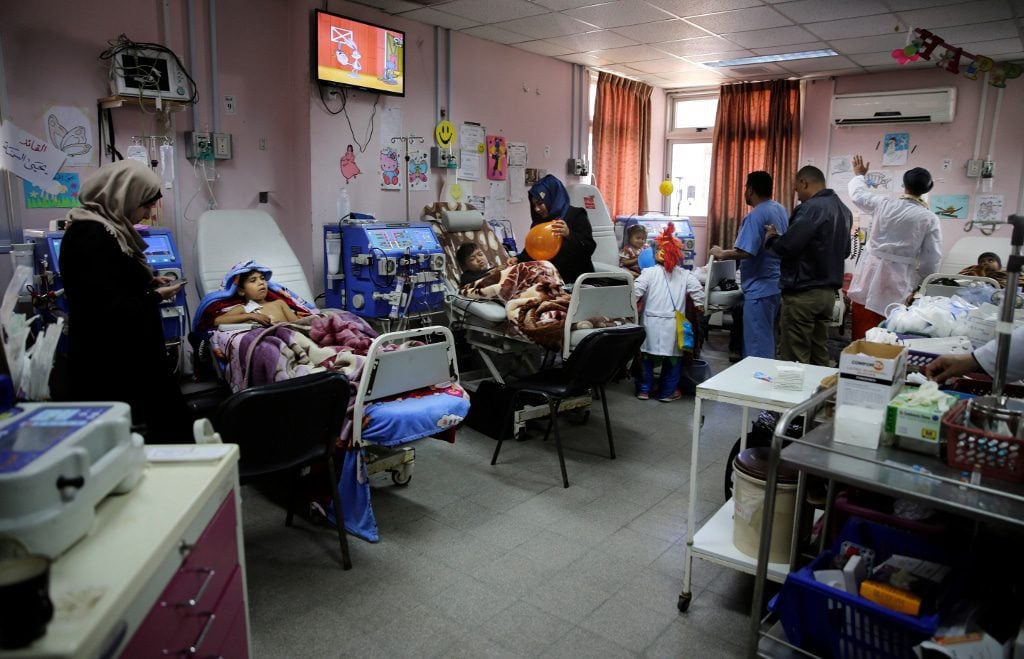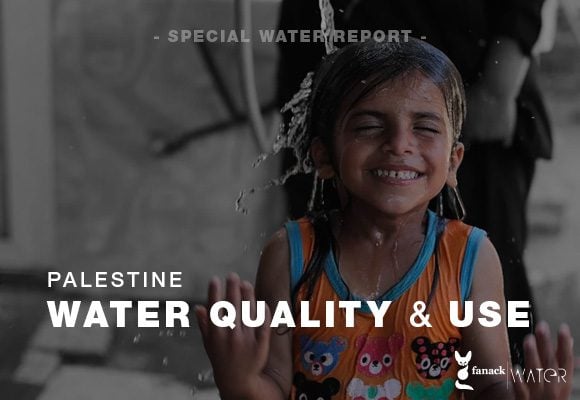
Introduction
There are several relevant bodies that are tasked with the provision of health services in the Palestinian territories, including the Ministry of Health, medical and military services, NGOs, civil society organizations, the United Nations Relief and Works Agency for Palestine Refugees (UNRWA) and the private sector. In addition, the Palestinian Authority (PA) allocates a large portion of its gross domestic product to the health sector. Yet the sector has not improved as expected since the establishment of the PA in 1994. Palestine ranks 113th in the Human Development Report 2015 published by the United Nations, which puts the country in the medium development category.
Facts and Figures
According to a report issued by the Palestinian Central Bureau of Statistics in September 2013, Palestine has 79 hospitals, with a total of 5,487 beds. Twenty five of these are government hospitals, offering 2,979 beds or 54.3 per cent of the total number of beds. Fifty four hospitals are private, with 2,508 beds or 45.7 per cent of the total number of beds. In addition, there are 750 primary healthcare centres, including 603 clinics and health centres in the West Bank and 147 centres in the Gaza Strip. Government healthcare centres account for approximately 61.3 per cent of the total number of healthcare centres.
In 2012, the number of physicians registered with the Palestinian Doctors Association was 8,810. The average number of physicians per 1,000 people was 2.2 (2.3 in the West Bank and 2.2 in the Gaza Strip). In the same year, Palestine had 11,633 registered nurses. The average number of nurses per 1,000 people was 2.7 (2.2 in the West Bank and 3.4 in the Gaza Strip).
The latest statistics for 2015 show that the average number of health sector workers rose significantly, with the number of general practitioners and specialists reaching 10,562. However, the ratio of hospitals and hospital beds to the population has largely stayed the same.
Negative Indicators in the Health Sector
The percentages mentioned above are considered to be positive compared with other developing countries in the region. Compared to developed countries like Germany, however, which has one doctor for every 210 people, this ratio is low. As for the number of beds in hospitals compared with the total population, there are 1.2 beds per 1,000 people, whereas Germany has 8.3 beds per 1,000 people.
Palestine also has a high incidence of chronic diseases, with approximately 18.1 per cent of Palestinians suffering from at least one chronic disease such as cancers, heart disease, diabetes and high blood pressure.
The main reason for this figure is the failure to promote public health as being based primarily on disease prevention, not treatment. This also covers the promotion of good nutrition, the health of women and children, and environmental factors, all of which contribute to the spread of infectious or chronic diseases.
Another negative indicator is the mortality rate among children under the age of five, which stands at 21 per 1,000 live births in the West Bank and 26.8 per 1,000 live births in the Gaza Strip. The infant mortality rate is 18.9 per 1,000 live births.
Perhaps the most important cause of these high numbers is malnutrition. As a result, the percentage of children under the age of five who suffer from moderate to severe stunting is 11.5 per cent in the West Bank and 10.4 per cent in the Gaza Strip.
Weaknesses in the Palestinian Health Sector
There are many indicators of weakness in the Palestinian health sector. Some of these are as follows:
Israeli Obstacles
The ongoing Israeli occupation and violations of Palestinian health rights are likely the most important reasons behind the weaknesses in the Palestinian health sector and its inability to improve. Since the first Palestinian uprising, Palestinian health facilities and ambulances have been targeted by Israeli forces. In addition, the more than decade-long blockade of the Gaza Strip severely inhibits the entry of medical supplies and foreign medical delegations to the cities and villages of the West Bank and the Gaza Strip.
Israeli checkpoints in the West Bank, which number nearly 500, and the separation wall built around the cities and villages of the West Bank, are also major obstacles to accessing emergency medical services. A large number of people in need of urgent medical treatment have lost their lives while waiting to pass Israeli checkpoints.
The three Israeli wars with Gaza between 2008 and 2014 created significant challenges for the health sector, especially because medical teams working in the Strip were unable to cope with the large numbers of deaths and injuries.
| WBGS | WB | GS | |
|---|---|---|---|
| Hospitalsof which: | 80 | 50 | 30 |
| Government | 25 | 12 | 13 |
| NGO | 34 | 20 | 14 |
| UNRWA | 1 | 1 | 0 |
| Military Medical Services | 3 | 0 | 3 |
| Private of which: | 17 | 17 | 0 |
| General | 46 | 27 | 19 |
| Specilised | 16 | 7 | 7 |
| Rehabilitation | 4 | 3 | 1 |
| Maternity | 16 | 13 | 3 |
| Hospital Beds | 5,619 | 3,263 | 2,356 |
| Hospital beds per 1,000 pop. (2013) | 1.25 | 1.2 | 1.4 |
| Bed Occupancy Rate (%) (2013) | 85.3 | 85.0 | 85.6 |
| Average Duration (days) | 2.4 | 2.2 | |
| Number of Primary Health Centers (2013)of which: | 759 | 622 | 147 |
| Government (Min. of Health) | 479 | 425 | 54 |
| NGO | 197 | 140 | 57 |
| UNRWA | 62 | 41 | 21 |
| Military Medical Services | 21 | 16 | 5 |
| Population per Primary Health Centers | 3,294 | 4,019 | |
| Number of Physicians (general and specialist) | 10,562 | 7,012 | 3,550 |
| Physicians per 10,000 pop. (2013) | 23.5 | ||
| Number of Dentists | 2,839 | 2,401 | 438 |
| Dentists per 10,000 pop. (2013) | 6.3 | ||
| Number of Pharmacists | 5,806 | 3,485 | 2,321 |
| Pharmacists per 10,000 pop. (2013) | 12.9 | ||
| Number of Nurses / Midwifes | 10,315/898 | 5,792/661 | 4,523/237 |
| Nursing/Midwifery per 10,000 pop. (2013) | 23.0/2.0 | ||
| Crude Birth Rate per 1,000 pop. (2013) | 25.9 | 22.3 | 31.7 |
| Crude Death Rate per 1,000 pop. (2013) | 2.5 | 2.5 | 2.1 |
| Total Fertility Rate (2013) | 4.4 | 4 | 5.2 |
| Infant Mortality Rate (2013) | 12.9 | ||
| Child Mortality Rate (2013) | 15.5 | ||
| Life Expectancy at Birth male-female (2013) | 71.5-74.4 | ||
| Maternal Mortality Rate per 10,000 live briths (2013) | 24.1 | 26.1 | 21.9 |
| Cancer Incidence Rate per 100,000 pop. (2013) | 79.5 | ||
| No. of referrals outside MOH facilities (2013) of which: | 61,635 | 44,244 | 17,635 |
| for treatment abroad | 11,233 | 4,512 | 6,721 |
| (of which Israel / Jordan / Egypt) | (8,118/256/2,859) | ||
| for treatment in East Jerusalem | 26,850 | 20,904 | 5,946 |
Poor Capabilities
1. At the same time, there are obvious weaknesses in the performance of medical teams, available capabilities and the maintenance and continuity of medical equipment, resulting in the inability to provide sufficient health services. These failings have aggravated Palestinians’ lack of confidence in their physicians. As a result, many Palestinians rely for treatment on referrals to Israeli, Jordanian or Egyptian hospitals, particularly in the case of cancer, heart and neurological disorders.
2. The shortage of financial resources is an obvious obstacle to the possible development of the health sector. Spending by government, NGOs, UNRWA clinics and the private sector has increased from $397.2 million in 2000 to about $1,347.4 million in 2013. However, this amount remains insufficient to achieve true development. Palestine spends only $248 per capita, compared with neighbouring Israel, which spends an average of around $2,046 per capita.
Medical Referrals
In view of the poor capabilities and medical equipment, as well as the inability of the medical staff to treat difficult cases, the Foreign Referral Department was established within the Ministry of Health. This gives referrals abroad for difficult medical cases such as malignant tumors, blood diseases and some complicated neural surgeries, surgeries related to cardiovascular diseases, child diseases, orthopedics and ophthalmology.
Dr Amirah al-Hindi, head of the department, said that the volume of work at the department is growing, with the number of referrals rising from 8,123 in 2000 to 64,219 in 2014. Referrals for patients from the Gaza Strip make up 27 per cent of the total number of annual referrals, and the monthly treatment bill ranges between 50 and 55 million shekels (around $14-15 million). Al-Hindi considers this increase to be a positive sign that health awareness among Palestinians is growing.
Observers note that patients from the Gaza Strip who seek treatment abroad face particular obstacles. Only a few of them are lucky enough to travel to Israel or Egypt, mainly because of the bureaucracy imposed by the Ministry of Health in Ramallah, which delays the referral of medical cases for several months until paperwork is completed.
A number of officials have criticized this delay, saying it humiliates patients from the Gaza Strip, and accused those who approve the referrals of financial corruption.
Another challenge facing Gazan patients seeking medical referrals abroad is the difficulty in obtaining travel permits from the Israeli and Egyptian authorities. According to a report issued by the World Health Organization in July 2016, Israeli authorities refuse to give travel permits to approximately three out of every ten patients requesting medical treatment in Israel every month.
Some 2,040 requests for travel permits from patients in the Gaza Strip were made in July 2016, 67 per cent of which were approved, whereas 190 requests, including for children, were denied. Some 473 requests did not even receive a response. At the Rafah crossing, only 79 patients were allowed to enter Egypt for treatment during the three days the crossing was open in July 2016.
Compared to previous years, the Israeli policy has not changed when it comes to turning down requests for medical referrals, including critical ones. Some of these patients have since died because they were unable to receive the treatment that could have saved them.
Some Positive Indicators Despite the Negatives
In light of the magnitude of the challenges facing the Palestinian government, and despite the fact that the health infrastructure is relatively new, some progress has been made, notably the Ministry of Health’s success in controlling many infectious diseases. The 2014 report issued by the Preventive Medicine Department at the Ministry of Health said that there had been no new reported cases of polio, cholera, tetanus, diphtheria, whooping cough, rubella or leprosy, although these diseases exist in neighbouring countries.
There are also several indicators of the high awareness of healthcare among Palestinians. Prenatal care, visiting qualified medical teams periodically and giving birth in health facilities have become widespread. In addition, hygiene and nutrition practices and awareness of the importance of physical exercise have improved among both men and women.
Another positive indicator is the tendency of Palestinian physicians to specialize in different medical majors, instead of being limited to general medicine. These specializations include heart surgery, neurosurgery, orthopedics and the treatment of different types of tumors and stroke-related diseases. Many complicated surgeries have been conducted in Ramallah, Nablus and the European Hospital in Gaza.

